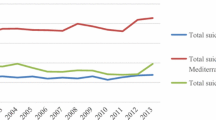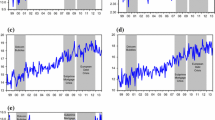Abstract
Objective
Suicides account for more than 30,000 deaths per year in the US alone. Suicide rates change over time, and the factors influencing them remain poorly understood. Economic factors, in particular unemployment, have been suggested as a major influence. However, the evidence for this has been inconsistent, which may be partly explained by shortcomings of the statistical methods used.
Methods
Time series analytical techniques (unit root and co-integration tests) were applied to test the associations over time between economic factors, i.e. unemployment, real gross domestic product per capita (RGDP) and the consumer price index (CPI) and death rates by suicide as collected by national agencies in the UK (1901–2006), US (1900–1997), France (1970–2004) and Italy (1970–2001). Traditional correlation analyses were used when appropriate.
Results
Co-integration and correlation tests showed a long-run association between economic factors and suicide rates. Increase/decrease of unemployment predicted an increase/decrease of suicide rates over long historical periods and in different nations. RGDP and the CPI were also linked with suicide rates, but this was not consistently so and the direction of the association varied.
Conclusions
Unemployment is a major factor influencing suicide rates over long periods of time and in different national contexts. It needs to be considered as a confounding factor in evaluations of suicide prevention strategies.
Similar content being viewed by others
Notes
In Table 1, we report the co-integrating vector only if the null hypothesis of no co-integration (i.e. r = 0) was rejected at the 5% significance level, whereas the null hypothesis r = 1 was not rejected at the 10% significance level. For instance the standardised co-integrating vector reported for France female population, S–U bivariate comparison “S − 0.30MA7(U)” means that the generalised Eigenvectors of A with respect to (A + c[A −1]/n 2)−1 for n = 4 and c = 1 are
$$ \begin{array}{*{20}c} {0.30} \hfill & 1 \hfill \\ 1 \hfill & { - 0.30} \hfill \\ \end{array} $$The last Eigenvector spans the space of co-integrating vectors and the space of co-integrating vectors is spanned by the following standardised vector
$$ \begin{array}{*{20}c} 1 \hfill & { \to {\text{Suicide}},\,{\text{females}},\,{\text{both}}\,{\text{sexes}}} \hfill \\ { - 0.30} \hfill & { \to {\text{Mov}} . {\text{Aver}}.7[U]} \hfill \\ \end{array} $$Regarding the direction of the association, if the sign of socio-economic variables was the opposite of S, the model predicted changes in the same direction, whilst the same sign predicted changes in the opposite direction.
In Table 2 we report a summary of pair-wise Johansen’s tests of co-integration among rates of suicide and economic variables. For brevity we reported only the error correction term whenever the null hypothesis of no co-integration (i.e. r = 0) was rejected at the 5% significance level (lambda-max test) and the null hypothesis r = 1 is not rejected at the 10% significance level (trace test) of a vector error correction model (VECM) with intercepts and co-integrating restrictions. The Standardised co-integrating vector is not reported in the tables but it can be easily derived from the error correction term. For instance in the co-integration model of S and U in France, the error correction term is S(−1) − 0.66MA7[U](−1) − 0.001(t − 1), and therefore the standardised co-integrating vector is S − 0.66MA7[U] − 0.001t, where MA7 stands for moving average after 7 periods.
References
Baumert J, Erazo N, Ruf E, Ladwig KH (2008) Time trends in suicide mortality vary in choice of methods. An analysis of 145, 865 fatal suicide cases in Germany 1991–2002. Soc Psychiatry Psychiatr Epidemiol 43:913–919
Berk M, Dodd S, Henry M (2006) The effect of macroeconomic variables on suicide. Psychol Med 36:181–189
Biddle L, Brock A, Brookes ST, Gunnell D (2008) Suicide rates in young men in England and Wales in the 21st century: time trend study. BMJ 336:539–542
Bierens HJ (1997) Testing the unit root hypothesis against nonlinear trend stationarity with an application to the price level and interest rate in the US. J Econom 81:29–64
Bierens HJ (1997) Nonparametric Co-integration analysis. J Econom 77:379–404
Bierens, HJ, EasyReg International, Department of Economics, Pennsylvania State University, University Park, PA 16802, USA. Accessed 10 April 2008. http://econ.la.psu.edu/~hbierens/EASYREG.HTM
Blakely TA, Collings SCG, Atkinson J (2003) Unemployment and suicide. Evidence for a causal association? J Epidemiol Community Health 57:594–600
Carter SB, Gartner SS, Haines MR, Olmstead AL, Sutch R, Wright G (2006) Historical statistics of the United States. Cambridge University Press, New York
CDC-Centers for Disease Control and Prevention, National Center for Injury Prevention and Control. Web-based Injury Statistics Query and Reporting System (WISQARS) www.cdc.gov/ncipc/wisqars. Accessed 10 April 2008
Ceccherini-Nelli A, Priebe S (2007) Economic Factors and psychiatric hospital beds—an analysis of historical trends. Int J Soc Econ 34:788–810
Chen VC-H, Chou J-Y, Lai T-J, Lee CT-C (2010) Suicide and unemployment rates in Taiwan, a population-based study, 1978–2006. Soc Psychiatry Psychiatr Epidemiol 45:447–452
Durkheim E (1897) On Suicide (2006) Richard Sennett (Introduction), Robin Buss (Translator) Penguin Classics, London
Graham E, Rothenberg TJ, Stock JH (1996) Efficient tests for an autoregressive unit root. Econometrica 64:813–836
Gibbons RD, Hur K, Bhaumik DK, Mann JJ (2005) The relationship between antidepressant medication use and rate of suicide. Arch Gen Psychiatry 62:165–172
Goldney RD, Schioldann JA (2000) Pre-Durkheim suicidology. Crisis 21:181–186
Hamilton JD (1994) Co-integration in time series analysis. Princeton University Press, Princeton, pp 571–629
Istituto Nazionale di Statistica (ISTAT). Il valore della moneta in Italia dal 1861 al 2006. Accessed 26 November 2007. http://www.istat.it/dati/catalogo/20071008_00/testointegrale20071008.pdf
Jin RL, Shah CP, Svoboda TJ (1995) The impact of unemployment on health: a review of the evidence. CMAJ 153:529–540
Johansen S (1988) Statistical analysis of co-integrating vectors. J Econ Dyn Control 12:231–254
Kelly BD, Davoren M, Mhaoláin AN, Breen EG, Casey P (2009) Social capital and suicide in 11 European countries: an ecological analysis. Soc Psychiatry Psychiatr Epidemiol 44:971–977
Kposowa AJ, D’Auria S (2010) Association of temporal factors and suicides in the United States 2000–2004. Soc Psychiatry Psychiatr Epidemiol 45:433–445
Lester D (1986) The interaction of divorce, suicide, and homicide. J Divorce 9:103–109
Lester BY (2001) Learning from Durkheim and beyond: the economy and suicide. Suicide Life Threat Behav 31:15–31
Luoto R, Poikolainen K, Uutela A (1998) Unemployment, sociodemographic background and consumption of alcohol before and during the economic recession of the 1990s in Finland. Int J Epidemiol 27:623–629
Mitchell BR (1988) British historical statistics. Cambridge University Press, New York
Norstrőm T (1995) The impact of alcohol, divorce and unemployment on suicide: a multilevel analysis. Soc Forces 74:293–314
Office For National Statistics (ONS) (2007) 20th century mortality (England and Wales 1901–2000) CD-ROM
Office For National Statistics (ONS) Mortality statistics: cause (Series DH2). Accessed 2 February 2008. http://www.statistics.gov.uk/StatBase/Product.asp?vlnk=618
Office For National Statistics (ONS)– MGSX. Unemployment % rate in UK; all, aged 16 and over time series. Accessed 2 February 2008. http://www.statistics.gov.uk/StatBase/TSDSelection1.asp
Officer LH (2008) What was the U.K. GDP then? MeasuringWorth.Com
Officer LH (2008) What were the UK earnings and prices then? MeasuringWorth.Com
Organisation for Economic Co-operation and Developmant (OECD) Statistics V.4.4. Accessed 26 November 2007. http://stats.oecd.org/wbos/default.aspx
Platt S (1984) Unemployment and suicidal behaviour: a review of the literature. Soc Sci Med 19:93–115
Phillips PCB, Perron P (1988) Testing for a unit root in time series regressions. Biometrika 75:335–346
South SJ (1985) Economic conditions and the divorce rate: a time-series analysis of the postwar United States. J Marriage Fam 47:31–41
Swinson N, Bettadapura A, Windfuhr K, Kapur N, Appleby L, Shaw J (2007) National confidential inquiry into suicide and homicide by people with mental illness: new directions. Psychiatr Bull 31:161–163
Tapia Granados JA (2005) Increasing mortality during the expansions of the US economy, 1900–1996. Int J Epidemiol 34:1194–1202
WHO (2007) Accessed 29 September 2007. http://who.int/mental_health/prevention/suicide/country_reports/en/
WHO Regional Office for Europe (2007) European Health for All Database, Copenhagen, Denmark. Accessed 26 November 2007. http://www.euro.who.int/HFADB
Conflict of interest
None.
Author information
Authors and Affiliations
Corresponding author
Rights and permissions
About this article
Cite this article
Ceccherini-Nelli, A., Priebe, S. Economic factors and suicide rates: associations over time in four countries. Soc Psychiatry Psychiatr Epidemiol 46, 975–982 (2011). https://doi.org/10.1007/s00127-010-0275-2
Received:
Accepted:
Published:
Issue Date:
DOI: https://doi.org/10.1007/s00127-010-0275-2




